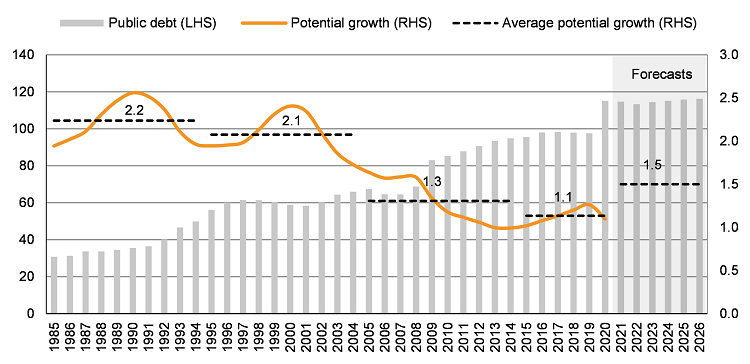Announcements
Drinks

France: credit outlook hinges on decisive post-election action on structural challenges
“France’s (AA/Stable) main structural challenges include high public debt and expenditures, productivity and competitiveness bottlenecks, labour market rigidities, as well as delivering on ambitious climate targets,” says Thomas Gillet, associate director at Scope Ratings.
“These challenges will require strong reform momentum while political fragmentation remains a major risk,” Gillet says.
A new government’s ability to legislate and implement these reforms and policies will ultimately determine whether they have a material impact on the country’s growth potential and public debt trajectory, which have followed opposite trends over the past forty years. Public debt will remain broadly stable in a baseline scenario, reaching 116% of GDP by 2026 assuming annual GDP growth of 1.5% -- in line with France’s potential – over the same period.
France’s public debt and GDP growth potential
% of GDP (LHS); % (RHS)
 Note: GDP growth potential estimates are from the OECD. Forecasts are from Scope Ratings
Note: GDP growth potential estimates are from the OECD. Forecasts are from Scope Ratings
Source: OECD, IMF, Scope Ratings GmbH
The main credit challenges for France include the risk to public finances from sustained deficits and elevated debt, exacerbated by the Covid-19 crisis, highlighting the need for gradual but ambitious fiscal consolidation.
“Higher spending related to social welfare makes pension reform one of the most important elements in the presidential candidates’ proposals,” says Thibault Vasse, senior analyst at Scope.
Elevated current expenditure has put pressure on public finances and constrains the government’s ability to consolidate. Pre-Covid, public spending stood at around 55% of GDP in 2019, about 10pp higher than the European average. The challenge for French governments is also that spending tends to be rigid, absorbed mostly by social security, including pensions and unemployment benefits, while the government’s wage bill at about 12% of GDP is higher than the European average of 10% of GDP. Reducing public spending inevitably involves politically sensitive and often unpopular reforms.
In addition, slowing productivity growth, weakening export performance, and deindustrialisation have progressively eroded potential GDP growth.
Another challenge are the remaining structural rigidities and skills mismatches in the labour market which have led to high unemployment, particularly among the young. “Supporting professional training and lifelong learning is critical to enhance economic opportunities and spur social mobility,” says Vasse.
A widening gap between ambitious climate goals and current results requires forceful policy action which may be hindered by social risks attached to rising prices of fossil fuels. “Candidates’ plans for nuclear and renewable energy are crucial, currently ranging from enthusiastic support for nuclear power to phasing it out,” says Brian Marly, analyst at Scope.





